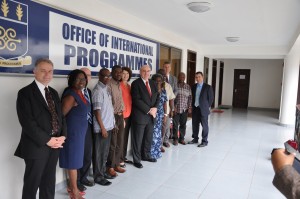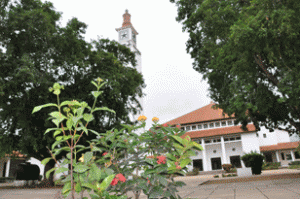Once a Hoosier, always a Hoosier, in Ghana
“Indiana University was, for me, an experience never to be forgotten.”
“I hope there will one day be another opportunity for me to go back to Bloomington.”
“I will always be a Hoosier.”
The final day of this historic IU presidential trip to Africa offered delegation members a chance to meet and talk with five faculty members at the University of Ghana, all of whom were once the beneficiaries of IU scholarships to study in Bloomington.
As each faculty member took turns telling his or her story before IU President Michael McRobbie, the first IU president ever to visit Ghana, it was impossible not to be struck — as delegation members have been at each stop on their journey — by IU’s remarkable impact here in sub-Saharan Africa, what the university has meant to so many African students throughout the years and the promise of IU’s increasing engagement in this dynamic part of the world.
Kodzo Gavua is a senior lecturer in the Department of Archaeology and Heritage Studies at the University of Ghana, Ghana’s oldest public university and an institution with more than 36,000 students. Through a student-exchange agreement between IU and UG, Gavua had the opportunity to come to IU in 2002 and spend a year working alongside faculty members in IU’s departments of anthropology and folklore and ethnomusicology. While at IU, he also sought instruction in computer literacy, music and basic studio engineering, and he even learned how to play West African percussion. Folks back home in Bloomington might remember him as the leader of the popular “Afro Hoosier Intl” dance band.
In 2009, Emmanuel Asampong was a visiting scholar in Bloomington, where he had the opportunity to assist in research on HIV being conducted by IU Bloomington School of Public Health Associate Dean Michael Reece and his team at the Center for Sexual Health Promotion. Today, he is a clinical psychologist and lecturer at UG’s school of the same name. While at IU, he helped link IU public health students and with students in Ghana who were studying similar topics. These online discussions, he said, addressed numerous misconceptions about Africa and helped prevent IU students from generalizing research findings about one country (Kenya, for example) to the whole of the continent.

The IU delegation poses with University of Ghana faculty members who were once the beneficiaries of IU scholarships to study in Bloomington.
If you needed to find Alexina Arthur during her time in Bloomington in 2002, you would have been well served to start in the Wells Library. The senior lecturer in the UG’s Department of Modern Languages and scholar of Russian literature says she spent the majority of her time at IU (time, she says, that was far too short!) devouring countless books and scouring newspaper archives documenting Russian-African relations when she wasn’t helping her daughter adjust to life and academic expectations as a Bloomington middle-school student.
“Indiana University has been very critical in the life of this university and in developing our faculty,” UG Pro-Vice Chancellor E. Kweku Osam told members of the IU delegation during a meeting in which leaders from both schools discussed ways to expand a partnership between IU and UG that dates back two decades and has generated numerous student and faculty exchange activities.
Indeed, IU had deep ties to Ghana, where more than 100 IU students studied abroad last year. Additionally, more than 20 students from Ghana were admitted to IU this fall.
Pro-Vice Chancellor Osam, who did his undergraduate work in linguistics at UG with Samuel Obeng, director of IU’s acclaimed African Studies Program, proudly mentioned that three current UG linguists received their training at IU.
In 2011, the IU Kelley School of Business’ innovative Global Business and Social Enterprise (GLOBASE) began sending Kelley MBA students to the country to act as business consultants to local entrepreneurs.
IU’s Mathers Museum of World Cultures has multiple ties to Ghana scholars. Most recently, IU art history graduate student and Mathers collaborator Brittany Sheldon, who is currently in Ghana, has developed an exhibition based on her research on traditional decoratively painted houses. Her exhibition, State of an Art: Contemporary Ghanaian Bambɔlse, will be presented this fall at the Ghana Museums and Monuments Board.
All in attendance at the meeting agreed that there was room to strengthen and expand the ties between their respective universities, particularly in areas in which IU’s strengths — including those in African language instruction, information technology and public health — align themselves with UG’s mission to enhance its research profile, increase its number of graduate-level students and become a more international university.
Not surprisingly, the meeting covered a great deal of common ground. It even produced a few interesting revelations, such as when UG’s Dean of International Programs Naa Adamafio told IU delegation members that her university currently boasts Africa’s best program in African studies, leaving the perfect opening for President McRobbie.
“So this means we both have the best programs on our respective continents!” McRobbie said, elicting a hearty laugh from the dean and her colleagues and ending the meetings at UG on a most positive note.
***
And so, a productive, memorable and inspiring presidential trip to South Africa, Kenya and Ghana comes to a close. I hope to recap some of the many highlights of this historic trip in the coming days, once the jet lag has subsided and we’ve all had a little time to reflect on the people we met, the places we were and the great potential we all were able to feel and experience in this amazing part of the world, one in which IU promises to be increasingly engaged in the years to come.
Until then, as they say in Kenya, asante sana!
Thank you very much for reading!
Tags: Accra, Africa, African Studies Program, Alexina Arthur, Brittany Sheldon, E. Kweku Osam, Emmanuel Asampong, Ghana, GLOBASE, Indiana University, IU, Kenya, Kodzo Gavua, Mathers Museum, Michael McRobbie, Michael Reece, Naa Adamafio, School of Public Health, South Africa, UG, University of Ghana



